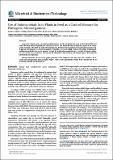Por favor, use este identificador para citar o enlazar a este item:
http://hdl.handle.net/10261/131140COMPARTIR / EXPORTAR:
 SHARE SHARE
 CORE
BASE CORE
BASE
|
|
| Visualizar otros formatos: MARC | Dublin Core | RDF | ORE | MODS | METS | DIDL | DATACITE | |

| Campo DC | Valor | Lengua/Idioma |
|---|---|---|
| dc.contributor.author | Zanini, Surama F. | es_ES |
| dc.contributor.author | Rodrigo Aliaga, Dolores | es_ES |
| dc.contributor.author | Pina Pérez, Maria Consuelo | es_ES |
| dc.contributor.author | Sanz Puig, María | es_ES |
| dc.contributor.author | Martínez López, Antonio | es_ES |
| dc.date.accessioned | 2016-04-15T12:44:36Z | - |
| dc.date.available | 2016-04-15T12:44:36Z | - |
| dc.date.issued | 2015-08-13 | - |
| dc.identifier.citation | Journal of Microbial & Biochemical Technology (2015) 7: 248-252 | es_ES |
| dc.identifier.uri | http://hdl.handle.net/10261/131140 | - |
| dc.description.abstract | Animal Feed has become an increasing critical component of the integrated food chain, in 2010 about 1000 mt of animal feed was produced globally and 150 mt in the EU27. The animal feed has an important impact in the human health. The farm or feedlot is the origin of microorganisms introduced onto carcasses during slaughter and dressing. It appears that changes in diet and management practices could precipitate increased shedding of pathogens. Additionally, antibiotics are used in animals, not only for treatment or prevent diseases, but also to promote growth. As a result of the use of antibiotics, food can contain antibiotic-resistant bacteria and resistance genes with important public health consequences. Although antibiotics are banned as growth promoters in the European Union and some other countries, this is not the case throughout the WHO European Region. Travel and the globalization of trade further increase the risk of spreading antibiotic-resistant bacteria. | es_ES |
| dc.language.iso | eng | es_ES |
| dc.publisher | OMICS Publishing Group | es_ES |
| dc.relation.isversionof | Publisher's version | es_ES |
| dc.rights | openAccess | es_ES |
| dc.subject | Animal feed | es_ES |
| dc.subject | Campylobacter jejuni | es_ES |
| dc.subject | Salmonella | es_ES |
| dc.subject | Escherichia coli | es_ES |
| dc.subject | Bacteria | es_ES |
| dc.title | Use of Antimicrobials from Plants in Feed as a Control Measure for Pathogenic Microorganisms | es_ES |
| dc.type | artículo | es_ES |
| dc.identifier.doi | 10.4172/1948-5948.1000218 | - |
| dc.description.peerreviewed | Peer reviewed | es_ES |
| dc.relation.publisherversion | http://dx.doi.org/10.4172/1948-5948.1000218 | es_ES |
| dc.identifier.e-issn | 1948-5948 | - |
| dc.relation.csic | Sí | es_ES |
| dc.type.coar | http://purl.org/coar/resource_type/c_6501 | es_ES |
| item.openairetype | artículo | - |
| item.grantfulltext | open | - |
| item.cerifentitytype | Publications | - |
| item.openairecristype | http://purl.org/coar/resource_type/c_18cf | - |
| item.fulltext | With Fulltext | - |
| item.languageiso639-1 | en | - |
| Aparece en las colecciones: | (IATA) Artículos | |
Ficheros en este ítem:
| Fichero | Descripción | Tamaño | Formato | |
|---|---|---|---|---|
| J Microb Biochem Technol-2015-248-.pdf | Artículo principal | 573,58 kB | Adobe PDF |  Visualizar/Abrir |
CORE Recommender
Page view(s)
263
checked on 19-abr-2024
Download(s)
245
checked on 19-abr-2024
Google ScholarTM
Check
Altmetric
Altmetric
Este item está licenciado bajo una Licencia Creative Commons

